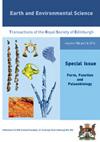First carnivorous fungus from Santonian Taimyr amber
IF 1.2
4区 地球科学
Q4 GEOSCIENCES, MULTIDISCIPLINARY
Earth and Environmental Science Transactions of the Royal Society of Edinburgh
Pub Date : 2023-06-13
DOI:10.1017/s1755691023000087
引用次数: 1
Abstract
Mycelium from the Yantardakh Lagerstätte (Santonian of Taimyr) is reported. Its hyphae are arranged mostly parallel, weakly branched and septated. The clamp connections indicate the Basidiomycota affinity. Two types of outgrowths are formed on the mycelium, located perpendicular to the parent hypha: the former rather long and common; and the latter are short peg-shaped, formed with a lower frequency. Arthroconidia and large spherical structures, looking like exudate drops are observed upon hyphae. Hyphae rings similar to the trapping loops of extant Basidiomycota have been found. Altogether, these rings, numerous drops and peg-like hyphal outgrowths may be interpreted as this mycelium belongs to nematophagous fungus of Agaricomycetes. Thus, this is the first finding of mycelium putatively nematophagous Basidiomycota from the Cretaceous of North Asia, which also implies the presence of nematodes in the Taimyr amber forest.Santonian Taimir琥珀中的第一种食肉真菌
报道了来自Yantardakh Lagerstätte(泰梅尔的Santonian)的菌丝体。菌丝排列大多平行,分枝微弱,有隔膜。夹钳连接表明担子菌门的亲和力。菌丝体上形成两种类型的生长物,垂直于母体菌丝:前者较长且常见;后者是以较低频率形成的短钉状。在菌丝上观察到节肢动物和大型球形结构,看起来像渗出液滴。已经发现类似现存担子菌门的菌丝环。总之,这些环、大量滴和栓状菌丝生长物可以解释为这种菌丝体属于琼脂纲的食线虫真菌。因此,这是在北亚白垩纪首次发现菌丝体,推测为食线虫担子菌门,这也意味着泰梅尔琥珀林中存在线虫。
本文章由计算机程序翻译,如有差异,请以英文原文为准。
求助全文
约1分钟内获得全文
求助全文
来源期刊
CiteScore
2.00
自引率
0.00%
发文量
21
期刊介绍:
Earth and Environmental Science Transactions (formerly Transactions of the Royal Society of Edinburgh: Earth Sciences) is a general earth sciences journal publishing a comprehensive selection of substantial peer-reviewed research papers, reviews and short communications of international standard across the broad spectrum of the Earth and its surface environments. The journal prides itself on the quality of its graphics and photographic reproduction. The Editors are keen to encourage interdisciplinary papers and Transactions also publishes occasional special symposia and invited volumes of specific interest.
We are currently in the process of digitising the archive of RSE Publications, and the archive of the Transactions, dating back to 1788, will be available from the back issues link on this site.

 求助内容:
求助内容: 应助结果提醒方式:
应助结果提醒方式:


